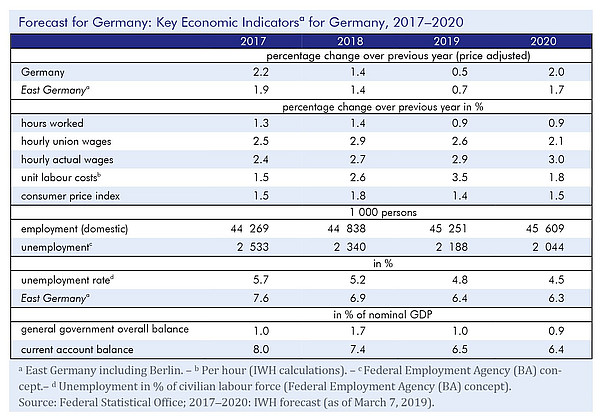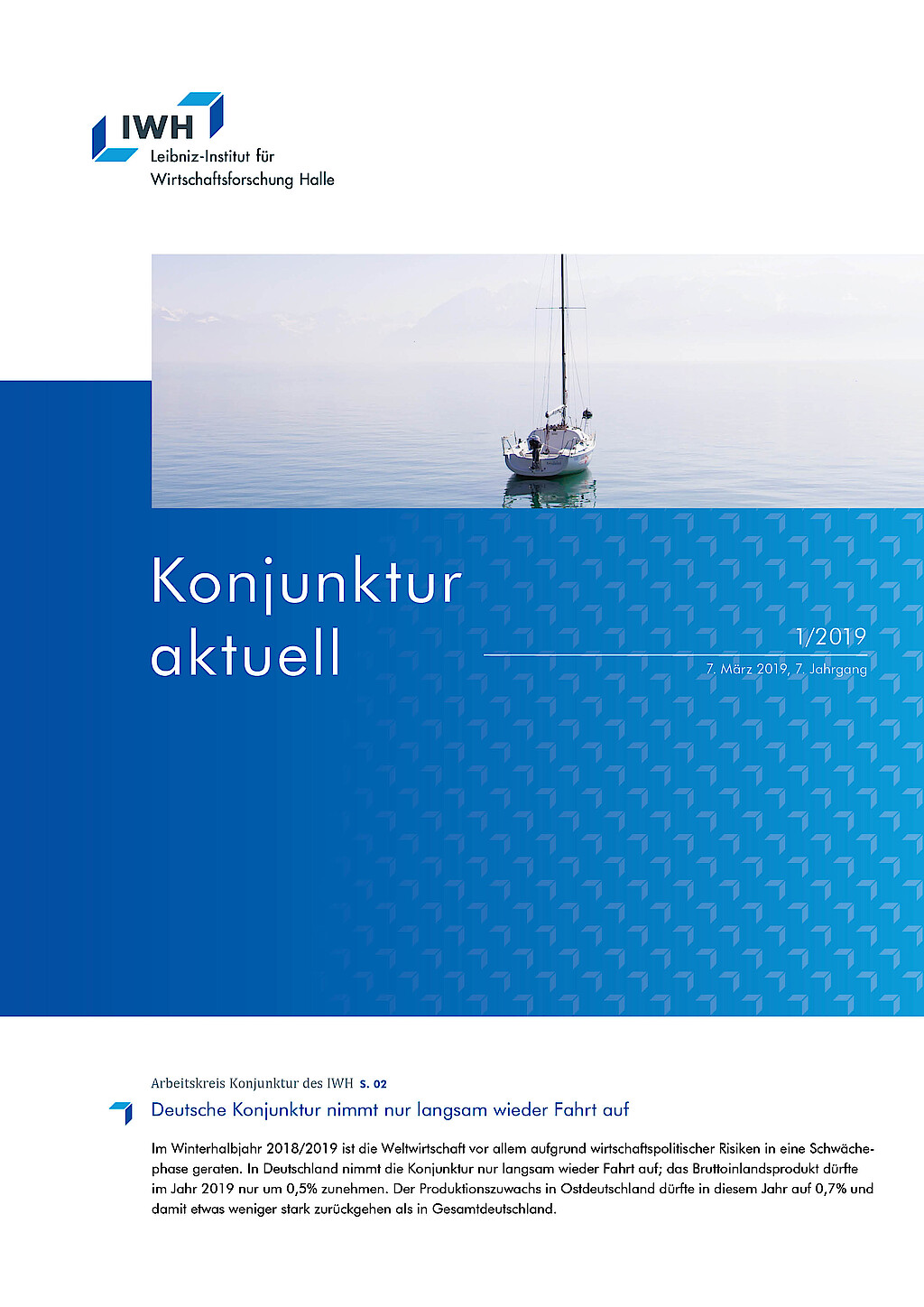German economy will pick up speed only slowly

In the winter half-year 2018/2019, the global economy has cooled off significantly. The economic development, however, diverges considerably between regions: the upturn in the USA has lost little momentum, while the recovery in the euro area has come to a standstill. The Chinese economy appears to be stumbling as well. One important reason for the slowdown in the global economy is the uncertainty surrounding the trade dispute between the United States on the one hand and China and the European Union on the other. For Europe, the unresolved Brexit negotiations put further strain on the economy. Although low interest rates and expansionary fiscal policies support the economy in the euro area, a sizeable pickup of the economy is likely to depend on further external stimulus, which might come when expansionary policy measures in China take effect in mid-2019.
In Germany, aggregate output stagnated in the final quarter of 2018, following a decline by 0.2% in the previous quarter. Problems of car producers adapting to a new emission gas test procedure, as well as the months-long failure of the Rhine as a waterway for the chemical industry, contributed to this weakness. More importantly, foreign demand, especially from the EU partner countries, has slowed down significantly. On the other hand, construction activity stays strong and companies continue building up employment, even, despite a decline in production, in the manufacturing sector. “Apparently, firms regard the current economic weakness as temporary, while the shortage of skilled workers is seen as a long-term problem. This has led, however, to a significant increase in unit labour costs”, says Oliver Holtemöller, head of the Department Macroeconomics and vice president at the Halle Institute for Economic Research (IWH). As a consequence, firms will not raise employment as fast as they did in 2018. According to the IWH Flash Indicator production in the first half of 2019 will barely grow. Still, private consumption is likely to expand robustly, not least because real wages continue rising. In addition, low interest rates and discretionary fiscal policies, which will amount to 0.7% of GDP in 2019, will help. Real gross domestic product will be 0.5% higher in 2019 than in the previous year. In 2020, the growth rate will increase to 2.0%, partly due to more working days in that year. The East German economy expands by 0.7% in 2019 and by 1.7% next year.
Publication
Brautzsch, Hans-Ulrich; Claudio, João Carlos; Drygalla, Andrej; Exß, Franziska; Heinisch, Katja; Holtemöller, Oliver; Kämpfe, Martina; Lindner, Axel; Müller, Isabella; Schultz, Birgit; Staffa, Ruben; Wieschemeyer, Matthias; Zeddies, Götz: Konjunktur aktuell: Deutsche Konjunktur nimmt nur langsam wieder Fahrt auf. Konjunktur aktuell, Jg. 7 (1), 2019. Halle (Saale) 2019.
Whom to contact
For Researchers

Vice President Department Head
If you have any further questions please contact me.
+49 345 7753-800 Request per E-MailFor Journalists

Internal and External Communications
If you have any further questions please contact me.
+49 345 7753-832 Request per E-MailIWH list of experts
The IWH list of experts provides an overview of IWH research topics and the researchers and scientists in these areas. The relevant experts for the topics listed there can be reached for questions as usual through the IWH Press Office.
Related Publications

Konjunktur aktuell: Deutsche Konjunktur nimmt nur langsam wieder Fahrt auf
in: Konjunktur aktuell, 1, 2019
Abstract
Im Winterhalbjahr 2018/2019 hat sich die Weltkonjunktur deutlich abgekühlt. Allerdings divergiert die Lage zwischen den Regionen erheblich: Der Aufschwung in den USA hat nur wenig an Fahrt verloren, im Euroraum ist er dagegen zum Erliegen gekommen. Auch in China ist die Wirtschaft ins Stocken geraten. Ein wichtiger Grund für die weltwirtschaftliche Schwächephase dürfte in der Unsicherheit darüber liegen, welche Wendung die Streitigkeiten der US-Regierung mit China und der Europäischen Union nehmen. Zudem sind alle Fragen um den Brexit weiterhin offen. In Deutschland hat die gesamtwirtschaftliche Produktion im Schlussquartal 2018 stagniert, nach einem Rückgang um 0,2% im Quartal zuvor. Zur Produktionsschwäche trugen mit dem neuen Abgas-Prüfverfahren für Automobile und dem niedrigen Rheinwasser zwei Sondereffekte bei. Mehr ins Gewicht fällt, dass sich die Auslandsnachfrage, vor allem aus den EU-Partnerländern, verlangsamt hat. Die Unternehmen bauen dennoch weiter Beschäftigung auf. Offensichtlich wird die gegenwärtige Schwächephase vielfach als vorübergehend eingeschätzt. Die Folge ist allerdings ein deutlicher Anstieg der Lohnstückkosten. Auch für das erste Halbjahr 2019 ist wenig mehr als Stagnation zu erwarten. Dennoch dürfte der private Konsum robust expandieren, nicht zuletzt wegen steigender Reallöhne. Zudem stützen die niedrigen Zinsen und eine expansive Finanzpolitik. Das reale Bruttoinlandsprodukt liegt nach vorliegender Prognose im Jahr 2019 um 0,5% höher als im Vorjahr, im Jahr 2020 steigt die Rate auch wegen der höheren Arbeitstagezahl auf 2,0%. Die ostdeutsche Wirtschaft expandiert in diesem Jahr um 0,7% und im Jahr 2020 um 1,7%.



